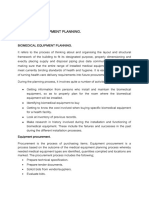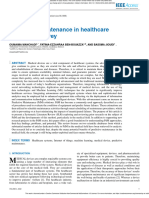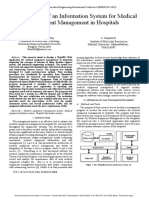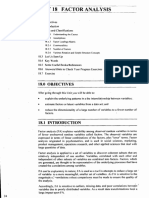Medical Equipment Management - Wikipedia
Medical Equipment Management - Wikipedia
Uploaded by
EzanaCopyright:
Available Formats
Medical Equipment Management - Wikipedia
Medical Equipment Management - Wikipedia
Uploaded by
EzanaCopyright
Available Formats
Share this document
Did you find this document useful?
Is this content inappropriate?
Copyright:
Available Formats
Medical Equipment Management - Wikipedia
Medical Equipment Management - Wikipedia
Uploaded by
EzanaCopyright:
Available Formats
Not logged in Talk Contributions Create account Log in
Article Talk Read Edit View history Search Wikipedia
Medical equipment management
From Wikipedia, the free encyclopedia
Main page
This article has multiple issues. Please help improve it or discuss these issues on the talk page. (Learn how [hide]
Contents
and when to remove these template messages)
Featured content
Current events This article may require cleanup to meet Wikipedia's quality standards. (December 2011)
Random article This article includes a list of references, related reading or external links, but its sources remain unclear because
Donate to Wikipedia it lacks inline citations. (March 2016)
Wikipedia store
Healthcare Technology Management (sometimes referred to as clinical engineering, clinical engineering management, clinical technology management, healthcare
Interaction
technology management, medical equipment management, biomedical maintenance, biomedical equipment management, and biomedical engineering) is a term for the
Help
professionals who manage operations, analyze and improve utilization and safety, and support servicing healthcare technology. These healthcare technology managers are,
About Wikipedia
Community portal much like other healthcare professionals referred to by various specialty or organizational hierarchy names.
Recent changes Some of the titles of healthcare technology management professionals are biomed, biomedical equipment technician, biomedical engineering technician, biomedical engineer,
Contact page
BMET, biomedical equipment management, biomedical equipment services, imaging service engineer, imaging specialist, clinical engineer technician, clinical engineering
Tools equipment technician, field service engineer, field clinical engineer, clinical engineer, and medical equipment repair person. Regardless of the various titles, these professionals
What links here offer services within and outside of healthcare settings to enhance the safety, utilization, and performance on medical devices, applications, and systems.
Related changes They are a fundamental part of managing, maintaining, and/or designing medical devices, applications, and systems for use in various healthcare settings, from the home and
Upload file
the field to the doctor's office and the hospital.
Special pages
Permanent link HTM includes the business processes used in interaction and oversight of the technology involved in the diagnosis, treatment, and monitoring of patients. The related policies
Page information and procedures govern activities such as the selection, planning, and acquisition of medical devices, and the inspection, acceptance, maintenance, and eventual retirement
Wikidata item and disposal of medical equipment.
Cite this page
Contents [hide]
Print/export
1 Responsibilities of the Healthcare Technology Management Professional
Download as PDF
2 Equipment Control & Asset Management
Printable version
3 Work Order Management
Languages 4 Data Quality Management
⽇本語 5 Quality Assurance
Edit links 6 Patient Safety
7 Risk management
8 Hospital Safety Programs
9 References
Responsibilities of the Healthcare Technology Management Professional [ edit ]
The healthcare technology management professional's purpose is to ensure that equipment and systems used in patient care are operational, safe, and properly configured to
meet the mission of the healthcare; that the equipment is used in an effective way consistent with the highest standards of care by educating the healthcare provider,
equipment user, and patient; that the equipment is designed to limit the potential for loss, harm, or damage to the patient, provider, visitor, and facilities through various means
of analysis prior to and during acquisition, monitoring and foreseeing problems during the lifecycle of the equipment, and collaborating with the parties who manufacture,
design, regulate, or recommend safe medical devices and systems.
Some but not all of the healthcare technology management professional's functions are:
Equipment Control & Asset Management
Equipment Inventories
Work Order Management
Data Quality Management
Equipment Maintenance Management
Equipment Maintenance
Personnel Management
Quality Assurance
Patient Safety
Risk Management
Hospital Safety Programs
Radiation Safety
Medical Gas Systems
In-Service Education & Training
Accident Investigation
Analysis of Failures, Root Causes, and Human Factors
Safe Medical Devices Act (SMDA) of 1990
Health Insurance Portability and Accountability Act (HIPAA)
Careers in Facilities Management
Equipment Control & Asset Management [ edit ]
Every medical treatment facility should have policies and processes on equipment control and asset management. Equipment control and asset management involves the
management of medical devices within a facility and may be supported by automated information systems (e.g., enterprise resource planning (ERP) systems are often found in
U.S. hospitals, and the U.S. military health system uses an advanced automated system known as the Defense Medical Logistics Standard Support (DMLSS) suite of
applications) or may use a dedicated equipment management and maintenance software (e.g., BME Assistor ). Equipment control begins with the receipt of a newly acquired
equipment item and continues through the item's entire lifecycle. Newly acquired devices should be inspected by in-house or contracted biomedical equipment technicians
(BMETs), who will receive an established equipment control/asset number from the facilities equipment/property manager. This control number is used to track and record
maintenance actions in their database. This is similar to creating a new chart for a new patient who will be seen at the medical facility. Once an equipment control number is
established, the device is safety inspected and readied for delivery to clinical and treatment areas in the facility.
Facilities or healthcare delivery networks may rely on a combination of equipment service providers such as manufacturers, third-party services, in-house technicians, and
remote support. Equipment managers are responsible for continuous oversight and responsibility for ensuring safe and effective equipment performance through full-service
maintenance. Medical equipment managers are also responsible for technology assessment, planning and management in all areas within a medical treatment facility (e.g.
developing policies and procedures for the medical equipment management plan, identifying trends and the need for staff education, resolution of defective biomedical
equipment issues).
This industry is new, and there is not a clear line between IT and Bio-Med.
Work Order Management [ edit ]
Work order management involves systematic, measurable, and traceable methods to all acceptance/initial inspections, preventive maintenance, and calibrations, or repairs by
generating scheduled and unscheduled work orders. Work order management may be paper-based or computer-base and includes the maintenance of active (open or
uncompleted) and completed work orders which provide a comprehensive maintenance history of all medical equipment devices used in the diagnosis, treatment, and
management of patients. Work order management includes all safety, preventive, calibration, test, and repair services performed on all such medical devices. A comprehensive
work order management system can also be used as a resource and workload management tool by managers responsible for personnel time, total number of hour’s technician
spent working on equipment, maximum repair dollar for one time repair, or total dollar allowed to spend repairing equipment versus replacement.
Post-work order quality checks involve one of two methods: 100% audit of all work orders or statistical sampling of randomly selected work orders. Randomly selected work
orders should place more stringent statistical controls based on the clinical criticality of the device involved. For example, 100% of items critical to patient treatment but only
50% of ancillary items may be selected for sampling. In an ideal setting, all work orders are checked, but available resources may dictate a less comprehensive approach.
Work orders must be tracked regularly and all discrepancies must be corrected. Managers are responsible to identify equipment location
Data Quality Management [ edit ]
Accurate, comprehensive data are needed in any automated medical equipment management system. Data quality initiatives can help to insure the accuracy of
clinical/biomedical engineering data. The data needed to establish basic, accurate, maintainable automated records for medical equipment management includes:
nomenclature, manufacturer, nameplate model, serial number, acquisition cost, condition code, and maintenance assessment. Other useful data could include: warranty,
location, other contractor agencies, scheduled maintenance due dates, and intervals. These fields are vital to ensure appropriate maintenance is performed, equipment is
accounted for, and devices are safe for use in patient care.
Nomenclature: It defines what the device is, how, and the type of maintenance is to be performed. Common nomenclature systems are taken directly from the ECRI
Institute Universal Medical Device Nomenclature System.
Manufacturer: This is the name of the company that received approval from the FDA to sell the device, also known as the Original Equipment Manufacturer (OEM).
Nameplate model: The model number is typically located on the front/behind of the equipment or on the cover of the service manual and is provided by the OEM. E.g.
Medtronic PhysioControl’s Lifepak 10 Defibrillator can actually be any one of the following correct model numbers listed: 10-41, 10-43, 10 -47, 10-51, and 10-57.
Serial number: This is usually found on the data plate as well, is a serialized number (could contain alpha characters) provided by the manufacturer. This number is crucial
to device alerts and recalls.
Acquisition cost: The total purchased price for an individual item or system. This cost should include installation, shipping, and other associated costs. These numbers are
crucial for budgeting, maintenance expenditures, and depreciation reporting.
Condition code: This code is mainly used when an item is turned in and should be changed when there are major changes to the device that could affect whether or not an
item should be salvaged, destroyed, or used by another Medical Treatment Facility.
Maintenance assessment: This assessment must be validated every time a BMET performs any kind of maintenance on a device.
Several other management tools, such as equipment replacement planning and budgeting, depreciation calculations, and at the local level literature, repair parts, and supplies
are directly related to one or more of these fundamental basics. Data Quality must be tracked monthly and all discrepancies must be corrected.
Quality Assurance [ edit ]
Quality Assurance is a way of identifying an item of supply or equipment as being defective. A good quality control/engineering program improves quality of work and lessens
the risk of staff/patient injuries/death.
Patient Safety [ edit ]
Safety of our patients/staff is paramount to the success of our organizations mission. The Joint Commission publishes annual lists detailing “National Patient Safety Goals” to
be implemented by healthcare organizations. Goals are developed by experts in patient safety nurses, physicians, pharmacists, risk managers, and other professionals with
patient-safety experience in a variety of settings. Patient safety is among the most important goals of every healthcare provider, and participation in a variety of committees and
processes concerned with patient safety provides a way for biomedical managers and clinical engineering departments to gain visibility and positively affect their workplace.
Risk management [ edit ]
This program helps the medical treatment facility avoid the likelihood of equipment-related risks, minimize liability of mishaps and incidents, and stay compliant with regulatory
reporting requirements. The best practice is to use a rating system for every equipment type. For example, a risk-rating system might rate defibrillators as considered high risk,
general-purpose infusion pumps as medium risk, electronic thermometers as low risk, and otoscopes as no significant risk. This system could be set up using Microsoft Excel
or Access program for a manager's or technician's quick reference.
In addition, user error, equipment abuse, no problem/fault found occurrences must be tracked to assist risk management personnel in determining whether additional clinical
staff training must be performed.
Risk management for IT networks incorporating medical devices will be covered by the standard ISO/IEC 80001. Its purpose is: "Recognizing that MEDICAL DEVICES are
incorporated into IT-NETWORKS to achieve desirable benefits (for example, INTEROPERABILITY), this international standard defines the roles, responsibilities and activities
that are necessary for RISK MANAGEMENT of IT-NETWORKS incorporating MEDICAL DEVICES to address the KEY PROPERTIES". It resorts some basic ideas of ISO
20000 in the context of medical applications, e.g. configuration, incident, problem, change and release management, and risk analysis, control and evaluation according to ISO
14971. IEC 80001 "applies to RESPONSIBLE ORGANIZATIONS, MEDICAL DEVICE manufacturers and other providers of information technologies for the purpose of
comprehensive RISK MANAGEMENT".
Hospital Safety Programs [ edit ]
The Joint Commission stipulates seven management plans for hospital accreditation. One of the seven is safety. Safety includes a range of hazards including mishaps, injuries
on the job, and patient care hazards. The most common safety mishaps are "needle-sticks" (staff accidentally stick themselves with a needle) or patient injury during care. As a
manager, ensure all staff and patients are safe within the facility. Note: it’s everyone’s responsibility!
There are several meetings that medical equipment managers are required to attend as the organizations technical representative:
Patient Safety
Environment of Care
Space Utilization Committee
Equipment Review Board
Infection Control (optional)
Educational Requirements For Bio-Medical Engineer : Students should take the most challenging science, math, and English courses available in high school. All
biomedical engineers have at least a bachelor's degree in engineering. Many have advanced graduate degrees as well. Courses of study include a sound background in
mechanical, chemical, or industrial engineering, and specialized biomedical training. Most programs last from four to six years, and all states require biomedical engineers to
pass examinations and be licensed.
Duties & Responsibilities For Bio-Medical Engineer: Description: Biomedical Engineers use engineering principles to solve health related and medical problems. They do a
lot of research in conjunction with life scientists, chemists, and medical professionals to design medical devices like artificial hearts, pacemakers, dialysis machines, and
surgical lasers. Some conduct research on biological and other life systems or investigate ways to modernize laboratory and clinical procedures. Frequently, biomedical
engineers supervise biomedical equipment maintenance technicians, investigate medical equipment failure, and advise hospitals about purchasing and installing new
equipment. Biomedical engineers work in hospitals, universities, industry, and research laboratories.
Working Conditions : Biomedical engineers work in offices, laboratories, workshops, manufacturing plants, clinics and hospitals. Some local travel may be required if medical
equipment is located in various clinics or hospitals. Most biomedical engineers work standard weekday hours. Longer hours may be required to meet research deadlines, work
with patients at times convenient to them, or work on medical equipment that is in use during daytime hours.
Duties : Biomedical engineers work closely with life scientists, chemists and medical professionals (physicians, nurses, therapists and technicians) on the engineering aspects
of biological systems. Duties and responsibilities vary from one position to another but, in general, biomedical engineers:
• design and develop medical devices such as artificial hearts and kidneys, pacemakers, artificial hips, surgical lasers, automated patient monitors and blood chemistry
sensors.
• design and develop engineered therapies (for example, neural-integrative prostheses).
• adapt computer hardware or software for medical science or health care applications (for example, develop expert systems that assist in diagnosing diseases, medical
imaging systems, models of different aspects of human physiology or medical data management).
• conduct research to test and modify known theories and develop new theories.
• ensure the safety of equipment used for diagnosis, treatment and monitoring.
• investigate medical equipment failures and provide advice about the purchase and installation of new equipment.
• develop and evaluate quantitative models of biological processes and systems.
• apply engineering methods to answer basic questions about how the body works.
• contribute to patient assessments.
• prepare and present reports for health professionals and the public.
• supervise and train technologists and technicians.
Biomedical engineers may work primarily in one or a combination of the following fields:
• bioinformatics – developing and using computer tools to collect and analyze data.
• bioinstrumentation – applying electronic and measurement techniques.
• biomaterials – developing durable materials that are compatible with a biological environment.
• biomechanics - applying knowledge of mechanics to biological or medical problems.
• bio-nano-engineering – developing novel structures of nanometer dimensions for application to biology, drug delivery, molecular diagnostics, microsystems and
nanosystems.
• biophotonics – applying and manipulating light, usually laser light, for sensing or imaging properties of biological tissue.
• cellular and tissue engineering – studying the anatomy, biochemistry and mechanics of cellular and sub-cellular structures, developing technology to repair, replace or
regenerate living tissues and developing methods for controlling cell and tissue growth in the laboratory.
• clinical engineering – applying the latest technology to health care and health care systems in hospitals.
• genomics and genetic engineering – mapping, sequencing and analyzing genomes (DNA), and applying molecular biology methods to manipulate the genetic material of
cells, viruses and organisms.
• medical or biological imaging – combining knowledge of a physical phenomenon (for example, sound, radiation or magnetism) with electronic processing, analysis and
display.
• molecular bioengineering – designing molecules for biomedical purposes and applying computational methods for simulating biomolecular interactions.
• systems physiology - studying how systems function in living organisms.
• therapeutic engineering – developing and discovering drugs and advanced materials and techniques for delivering drugs to local tissues with minimized side effects.
References [ edit ]
Bowles, Roger "Techcareers: Biomedical Equipment Technicians" TSTC Publishing
Dyro, Joseph., Clinical Engineering Handbook (Biomedical Engineering).
Khandpur, R. S. "Biomedical Instrumentation: Technology and Applications". McGraw Hills
Northrop, Robert B., "Noninvasive Instrumentation and Measurement in Medical Diagnosis (Biomedical Engineering)".
Webb, Andrew G., "Introduction to Biomedical Imaging (IEEE Press Series on Biomedical Engineering)".
Yadin David, Wolf W. von Maltzahn, Michael R. Neuman, and Joseph D. Bronzino,. Clinical Engineering (Principles and Applications in Engineering).
Villafañe, Carlos CBET: "Biomed: From the Student's Perspective" (ISBN 978-1-61539-663-4). www.Biomedtechnicians.com.
Willson K., Ison K., Tabakov S., "Medical Equipment Management", CRC Press
Categories: Medical equipment
This page was last edited on 4 September 2019, at 13:26 (UTC).
Text is available under the Creative Commons Attribution-ShareAlike License; additional terms may apply. By using this site, you agree to the Terms of Use and Privacy Policy. Wikipedia® is a registered
trademark of the Wikimedia Foundation, Inc., a non-profit organization.
Privacy policy About Wikipedia Disclaimers Developers Statistics Cookie statement Mobile view Contact Wikipedia
You might also like
- CPHIMS Flashcard Study Guide PDFDocument59 pagesCPHIMS Flashcard Study Guide PDFVenkat ThejaNo ratings yet
- Post-Placement Learning Plan 2018Document2 pagesPost-Placement Learning Plan 2018api-393048315No ratings yet
- ThesisDocument60 pagesThesisMICHAELNo ratings yet
- Curriculum - IESE B SchoolDocument38 pagesCurriculum - IESE B SchoolJatin AnandNo ratings yet
- Inventory JournalDocument6 pagesInventory JournalhendranatjNo ratings yet
- The Medical Equipment Management Information SystemDocument44 pagesThe Medical Equipment Management Information SystemsebsibehannaNo ratings yet
- Biomedical Engineering Department Organizational StructureDocument3 pagesBiomedical Engineering Department Organizational StructureFlame St100% (2)
- Guidance For Industry On Management of Cybersecurity in Medical Devices (TFDA)Document13 pagesGuidance For Industry On Management of Cybersecurity in Medical Devices (TFDA)Benny KuehNo ratings yet
- Biomedical Equip PlanningDocument6 pagesBiomedical Equip PlanningOcwich FrancisNo ratings yet
- MODULE 2: Information Technology System Applicable in Nursing PracticeDocument4 pagesMODULE 2: Information Technology System Applicable in Nursing PracticejuiceNo ratings yet
- L9-Health Data Privacy, Confidentiality and Security (1)Document14 pagesL9-Health Data Privacy, Confidentiality and Security (1)yasr8447No ratings yet
- How Clinical Engineer Enhance Patient SafetyDocument11 pagesHow Clinical Engineer Enhance Patient Safety770ahlamNo ratings yet
- His DefDocument6 pagesHis DefSaba Abu FarhaNo ratings yet
- Principles of Health InformaticsDocument9 pagesPrinciples of Health InformaticsAnisha Vadakkepatt100% (4)
- Irjet V11i3203Document6 pagesIrjet V11i3203bashakalam67No ratings yet
- Dbms Final ReportDocument58 pagesDbms Final Reportambatikarthik12No ratings yet
- Blockchain For EhrDocument10 pagesBlockchain For EhrakanshaNo ratings yet
- greyyallDocument4 pagesgreyyalljumana.elashryNo ratings yet
- The Importance and Implementation of Incident Management SystemsDocument7 pagesThe Importance and Implementation of Incident Management Systemspradeepn.designerNo ratings yet
- Hospital Management-Unit 1Document5 pagesHospital Management-Unit 1srivardhiniduraiselvanNo ratings yet
- Hospital Management System 2023-24Document15 pagesHospital Management System 2023-24skandapmwork2003No ratings yet
- Predictive Maintenance in Healthcare System A SurvDocument18 pagesPredictive Maintenance in Healthcare System A SurvPedro SeguraNo ratings yet
- LMOME01Document10 pagesLMOME01BarathNo ratings yet
- Equipment Management Systems For Developing CountriesDocument3 pagesEquipment Management Systems For Developing CountriesTendayi J GatsiNo ratings yet
- A Model-Integrated Guideline-Driven Clinical Decision-Support SystemDocument8 pagesA Model-Integrated Guideline-Driven Clinical Decision-Support Systemankur.ghoshNo ratings yet
- HTMC 2202Document16 pagesHTMC 2202Ashenafi AbiyoNo ratings yet
- 1 Chap 1 Part 1Document5 pages1 Chap 1 Part 1CAÑADA, JOHANNELYN M.No ratings yet
- Development of An Information System For Medical Equipment Management in HospitalsDocument5 pagesDevelopment of An Information System For Medical Equipment Management in Hospitalsنايف المطيريNo ratings yet
- Organization Rolebiomedicalengineers 2017Document11 pagesOrganization Rolebiomedicalengineers 2017omersinga00No ratings yet
- Risk Management For Medical Devices: Calin - Corciova@bioinginerieDocument6 pagesRisk Management For Medical Devices: Calin - Corciova@bioinginerieYudi Wahyudi WahyudiantoNo ratings yet
- AI in Healthcare in IndiaDocument16 pagesAI in Healthcare in IndiaRavi GoyalNo ratings yet
- Chapter 10 - Trustworthy System For Safe and Private HealthcareDocument28 pagesChapter 10 - Trustworthy System For Safe and Private HealthcarejoaguilarNo ratings yet
- IoMT Security Standard For Healthcare V 0614102020Document11 pagesIoMT Security Standard For Healthcare V 0614102020joweb73078No ratings yet
- Organization Rolebiomedicalengineers 2017Document18 pagesOrganization Rolebiomedicalengineers 2017omersinga00No ratings yet
- Hospital Equipment and Its Management System A MinDocument4 pagesHospital Equipment and Its Management System A MinPaola LorenzattoNo ratings yet
- Project Template 2023-24Document7 pagesProject Template 2023-24vaishnavi.shingote111No ratings yet
- Hospital Training Content - RajeshDocument72 pagesHospital Training Content - RajeshBME 044 RAJESH KUMAR KNo ratings yet
- Ijeit1412201507 06Document4 pagesIjeit1412201507 06olaoludare11No ratings yet
- Pitch - 13SQFT AmsDocument10 pagesPitch - 13SQFT AmsAmber GuptaNo ratings yet
- Biomedical Hospital EquipmentDocument6 pagesBiomedical Hospital Equipmentee113051No ratings yet
- Bulletin Healthcare Organisations 03142023Document46 pagesBulletin Healthcare Organisations 03142023dodyNo ratings yet
- PECSET Handbook - 011123 - MP - TaiwanDocument25 pagesPECSET Handbook - 011123 - MP - TaiwanGhayoor ChanNo ratings yet
- Medical Equipment Management PolicyDocument22 pagesMedical Equipment Management PolicymusokeNo ratings yet
- Pitch - 13SQFT AmsDocument10 pagesPitch - 13SQFT AmsAmber GuptaNo ratings yet
- Presentation 1Document31 pagesPresentation 1braagamer82No ratings yet
- Lec 1 Introduction To Biosafety SNDocument44 pagesLec 1 Introduction To Biosafety SNHiba ShakilNo ratings yet
- Health Information TechnologyDocument2 pagesHealth Information TechnologyNádia SantosNo ratings yet
- Life Support Is 4.0 SupportDocument57 pagesLife Support Is 4.0 Supportgozalie harunNo ratings yet
- Codebeamer Template Medical Software EngineeringDocument12 pagesCodebeamer Template Medical Software Engineeringhamed IranpourNo ratings yet
- Comprehensive Guide To Risk Management in Medical Device ProjectsDocument4 pagesComprehensive Guide To Risk Management in Medical Device Projectsjicet67288No ratings yet
- Tekgem IACS Cyber Security AssessmentDocument8 pagesTekgem IACS Cyber Security AssessmentLynsey StephensonNo ratings yet
- Student InnovationDocument6 pagesStudent Innovationxodowak182No ratings yet
- AM21332 - Class 1Document11 pagesAM21332 - Class 1Jyotsna Singh MertiaNo ratings yet
- Lista 2024 Segurança Do Paciente - InternacionalDocument31 pagesLista 2024 Segurança Do Paciente - InternacionalJade DiasNo ratings yet
- Lec 1Document28 pagesLec 1Omar MagdyNo ratings yet
- Case Study Mental Health Care Patient Management System (MHCPMS)Document15 pagesCase Study Mental Health Care Patient Management System (MHCPMS)advifulNo ratings yet
- How To Organize The Maintenance of Your Healthcare TechnologyDocument240 pagesHow To Organize The Maintenance of Your Healthcare TechnologybprzNo ratings yet
- ISO 13485 Training DocsDocument67 pagesISO 13485 Training Docspurvi soniNo ratings yet
- 02 Clinical EngineeringDocument47 pages02 Clinical Engineeringamirali.bme4527No ratings yet
- OlusanyElegbedeandOgunseye WordDocument6 pagesOlusanyElegbedeandOgunseye Worddishavkumar6No ratings yet
- Olu Sanye Leg Be Dean Do Guns EyeDocument6 pagesOlu Sanye Leg Be Dean Do Guns EyeItz HarlartiseyNo ratings yet
- Application of Intelligent Medical Equipment ManagementDocument12 pagesApplication of Intelligent Medical Equipment ManagementAbebeNo ratings yet
- EHR Systems Administrator - The Comprehensive Guide: Vanguard ProfessionalsFrom EverandEHR Systems Administrator - The Comprehensive Guide: Vanguard ProfessionalsNo ratings yet
- PPM For Laundry MachineDocument1 pagePPM For Laundry MachineEzanaNo ratings yet
- Corrective Maintenance ReportDocument2 pagesCorrective Maintenance ReportEzanaNo ratings yet
- Corrective Maintenance ReportDocument1 pageCorrective Maintenance ReportEzanaNo ratings yet
- Acceptance Format2Document4 pagesAcceptance Format2EzanaNo ratings yet
- Incident Report FormDocument1 pageIncident Report FormEzanaNo ratings yet
- Addis Ababa HospitalsDocument26 pagesAddis Ababa HospitalsEzanaNo ratings yet
- Corrective Maintenance ChecklistDocument2 pagesCorrective Maintenance ChecklistEzanaNo ratings yet
- Making It WorkDocument53 pagesMaking It WorkEzanaNo ratings yet
- Medical Devices EquipmentDocument30 pagesMedical Devices EquipmentEzanaNo ratings yet
- HPMI For Print April.11Document118 pagesHPMI For Print April.11Ezana100% (1)
- Ethiopian Hospital Services Trasformation Guidelines (Ehstg)Document112 pagesEthiopian Hospital Services Trasformation Guidelines (Ehstg)Ezana50% (2)
- Saca 19200 SpecDocument1 pageSaca 19200 SpecEzanaNo ratings yet
- Full Download Brothers and Sisters: Sibling Relationships Across the Life Course 1st ed. Edition Ann Buchanan PDF DOCXDocument66 pagesFull Download Brothers and Sisters: Sibling Relationships Across the Life Course 1st ed. Edition Ann Buchanan PDF DOCXbestedmoina100% (5)
- Coursework Formative Assessment Brief: Programme Name: MSC ManagementDocument4 pagesCoursework Formative Assessment Brief: Programme Name: MSC ManagementSammar AbbasNo ratings yet
- An Analysis of Current Awareness Services and Selective Dissemination of Information in University of JOS LibraryDocument12 pagesAn Analysis of Current Awareness Services and Selective Dissemination of Information in University of JOS LibraryTiago AlmeidaNo ratings yet
- Key Account ManagementDocument4 pagesKey Account ManagementAditya Malik100% (1)
- RforPoliticalDataScienceAPracticalGuide BookreviewDocument3 pagesRforPoliticalDataScienceAPracticalGuide BookreviewAmeyalli ValentinNo ratings yet
- Coopetition Where Do You Come From IdentificationDocument19 pagesCoopetition Where Do You Come From IdentificationYassirZariNo ratings yet
- Impact of Artificial Intelligence Ai On The Ecommerce Business Empirical Analysis For Optimal Use of The ChatbotDocument8 pagesImpact of Artificial Intelligence Ai On The Ecommerce Business Empirical Analysis For Optimal Use of The ChatbotceritachikoNo ratings yet
- Marketing Strategy of AmulDocument56 pagesMarketing Strategy of AmulMaster PrintersNo ratings yet
- Project Study 2Document41 pagesProject Study 2James AlcariaNo ratings yet
- Using Safety Cases in Industry and HealthcareDocument44 pagesUsing Safety Cases in Industry and Healthcaremaheshwaghe272No ratings yet
- Dungeons, Dragons, and Drama Therapy - A Digital Approach For Teenagers On TheDocument61 pagesDungeons, Dragons, and Drama Therapy - A Digital Approach For Teenagers On TheIsaac FullartonNo ratings yet
- The State of The Art of Agile Kanban Method ChalleDocument16 pagesThe State of The Art of Agile Kanban Method Challe21P113 - MOHAMMED FAHAD ANo ratings yet
- Research Proposal Template - FYPDocument9 pagesResearch Proposal Template - FYPKamran SH100% (1)
- 1 s2.0 S2211926423000280 MainDocument17 pages1 s2.0 S2211926423000280 Mainadi arthaNo ratings yet
- I Nyoman Surya Dharma - Paper AnalysisDocument5 pagesI Nyoman Surya Dharma - Paper AnalysisKomang Dio Surya DharmaNo ratings yet
- Does School Give Too Much HomeworkDocument4 pagesDoes School Give Too Much Homeworklip0lomyjof3100% (1)
- ISATIS 2016 Beginner's GuideDocument240 pagesISATIS 2016 Beginner's Guidejoseps andradeNo ratings yet
- Modelica FaltTreeDocument11 pagesModelica FaltTreeFalak SherNo ratings yet
- 02 MarxDocument10 pages02 MarxTeacher ShyneNo ratings yet
- Critical Literature Review SamplesDocument6 pagesCritical Literature Review Samplesc5hfb2ct100% (1)
- Report Performance Appraisal of Square Pharmaceutical LTDDocument21 pagesReport Performance Appraisal of Square Pharmaceutical LTDMd Hasib A Rahman TonmoyNo ratings yet
- Accounting Theory Conceptual Issues in A Political and Economic Environment 9th Edition Wolk Solutions Manual Full Chapter PDFDocument32 pagesAccounting Theory Conceptual Issues in A Political and Economic Environment 9th Edition Wolk Solutions Manual Full Chapter PDFmaximusnhator1100% (23)
- Unit 18Document9 pagesUnit 18Muhammed Mikhdad K G 21177No ratings yet
- Sheila Marie Bangco - MODULE 3 Lesson 4,5,6 - Dr. Jubahib, Prof Villabrille, Dr. CallaDocument20 pagesSheila Marie Bangco - MODULE 3 Lesson 4,5,6 - Dr. Jubahib, Prof Villabrille, Dr. CallaSheila Marie BangcoNo ratings yet
- Predictive Maintenance of Armoured Vehicles Using Machine Learning ApproachesDocument7 pagesPredictive Maintenance of Armoured Vehicles Using Machine Learning Approachescawetaj550No ratings yet
- Different Approaches To Design ManagementDocument7 pagesDifferent Approaches To Design ManagementCarlos GonzalezNo ratings yet
- Anumba-2018-The Obstetrician & GynaecologistDocument3 pagesAnumba-2018-The Obstetrician & GynaecologistAnoopNo ratings yet





































































































